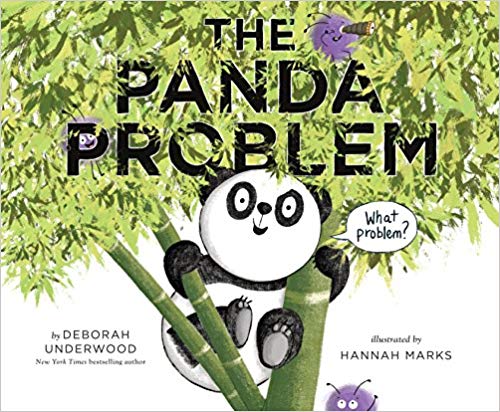The Panda Problem
Author: Deborah Underwood
Illustrator: Hannah Marks
Dial Books
2 April 2019
48 pages
This month’s PB review is by Ryan G. Van Cleave (Biggest Panda Fan at Only Picture Books) and OPB review newcomer, Florida author-illustrator Loreen Leedy.
–Ryan’s Review of the Writing–
One thing that we’ve come to expect from Underwood’s books is how stories themselves are often part of the story. In her latest picture book, The Panda Problem, that’s exactly what’s happening. A Narrator (yes, that’s with a capital N since this one’s quite the active character here) is trying to set up a story about Panda in a “beautiful bamboo grove,” but despite the Narrator’s insistence that a main character has to have a problem, Panda claims to not have one. “Looks like you’re the one with a problem, buddy,” Panda explains to the Narrator.
The story gets fairly chaotic from there in a fun way that will delight readers, especially once the setting moves far from the bamboo grove. Thankfully, the art clearly showcases the two distinct voices. Panda’s words are always in cartoon-style speech bubbles, and those by the Narrator look like regular text on the page, which gives the words an adult, authorial seriousness to them. Together, they create a fast-paced dialogue that roars along as Panda tries to help make the story, well, a story. Sort of.
A bonus is that Underwood includes plenty of kid-pleasing sound effects, as well (witness a spider who says “BRAAAAP!” and the GLUG GLUG SLOSH of Panda’s paper boat wipeout).
While other picture book authors have had characters who wrest control of the story from a narrator/author, Underwood’s adorable Panda does it in a fun, memorable way that doesn’t get overly meta and also introduces readers to storytelling techniques (such as dialogue and the escalation of stakes).
Even though I’m an admitted panda bear fan, this is a highly entertaining, witty read regardless.
4.25 out of 5 pencils
– Loreen’s Review of the Illustrations–
The premise of this cheeky picture book can be found on the book jacket as Panda disputes the title The Panda Problem right on the front cover by asking, “What problem?” Mysterious round purple characters hint at mysteries to unfold. On the back cover, Panda is smirking after drawing a line through the floating headline NO PROBLEM, NO STORY and rewriting it as NO STORY, NO PROBLEM!
Continuing the theme, the front flap copy originally stated that the author “…puts readers in control of this story.” However, our main character has revised it to read “…puts readers PANDA in control of this story.” The back flap copy has likewise been extensively revised by the irrepressible bear.
The color scheme is at first limited to black, white, olive greens, and purple only. The digitally painted illustrations include bamboo stalks with a subtle cloth texture and energetic dry brushed leaves, while Panda has loosely drawn line work enclosing the white parts of the body. Backgrounds are primarily white space in the beginning of the book, keeping the focus on Panda and the argument with the Narrator about whether or not Panda needs a story problem to be solved. The empty white space can also be an indication of the (seemingly) unfinished state the story is in.
As the debate continues, one spread is filled with possible problems proposed by the Narrator such as “Are you afraid of spiders?” or “Is your paw sore?” and Panda’s repeated answers, “Nope.” Once they’re mentioned, comical spiders appear in the artwork. The Narrator’s words are in a clean sans serif font while Panda speaks with lively handwritten words inside expressive speech balloons with oval, undulating, or spiky shapes. When the Narrator gets especially frustrated, her words are set in ALL CAPS.
Rich photographic textures add interest and additional colors to the illustrations, such as woven fibers in a hammock, wood grain in a banjo, and crumpled paper in a sailboat. As Panda induces a multi-hued torrent of jelly beans by merely mentioning the possibility, the Narrator loses control of events. At this point the aliens arrive, portrayed as happy purple fuzzballs who accompany Panda to Antarctica.
The scenes become increasingly chaotic as spiders, penguins, aliens, and (suddenly) twin pandas sail across the icy waters then are shipwrecked. Panda’s worried face is seen in extreme close-up while finally giving in and admitting there’s a problem. After wailing about their hunger and the complete lack of bamboo in Antarctica, the two pandas make a deal for the Narrator to take over again, sort of. The last page is blank except for the Narrator’s final, satisfying word.
Self-taught illustrator and designer Hannah Marks lives and works in England; The Panda Problem is her first picture book released in the United States. The design of the type and illustrations perfectly complement and extend the concepts within about the power of words, creativity, writing, characters, illustration, and of course, story problems.
4 out of 5 crayons

Loreen Leedy is the author-illustrator of more than 40 popular picture books that have received many rave reviews and honors. Her titles such as Measuring Penny, Amazing Plant Powers, and Crazy Like a Fox: A Simile Story often include math, science, and language arts content. Her most recent book, Step by Step, features footprints made by baby animals including a puppy, duckling, and fawn in a page-turning question and answer format. It makes an appealing nonfiction choice for preschool, kindergarten, and first grade age levels.
To see Loreen’s work and download free book activity printables, please visit www.LoreenLeedy.com.


